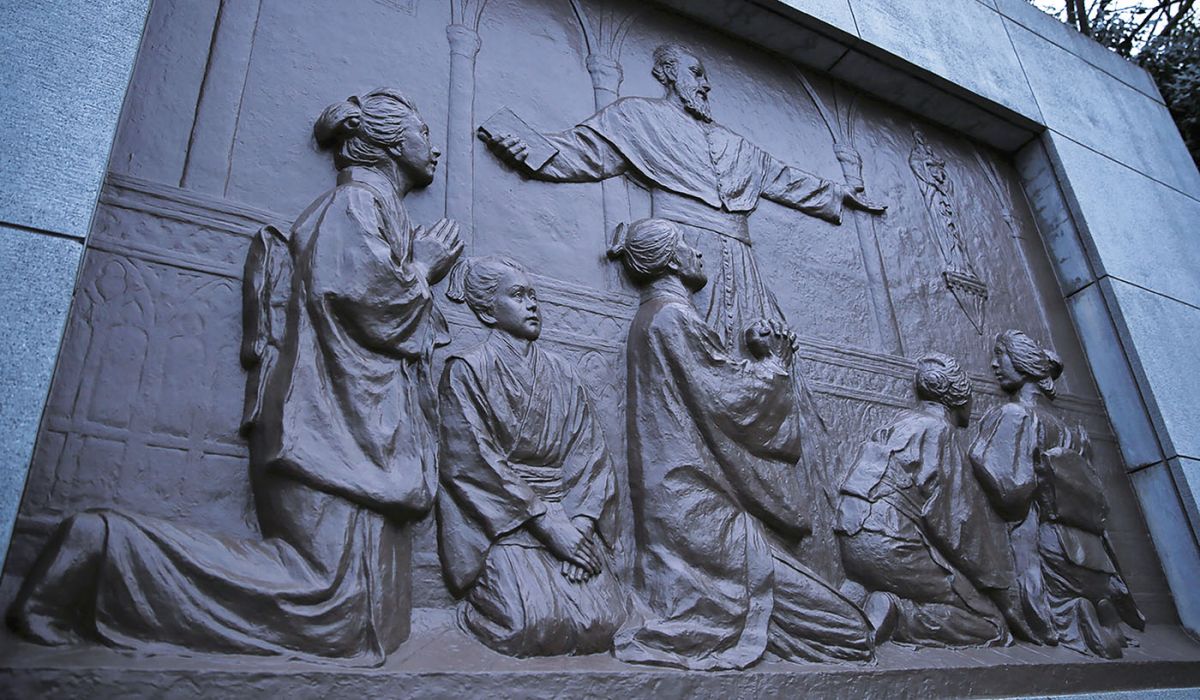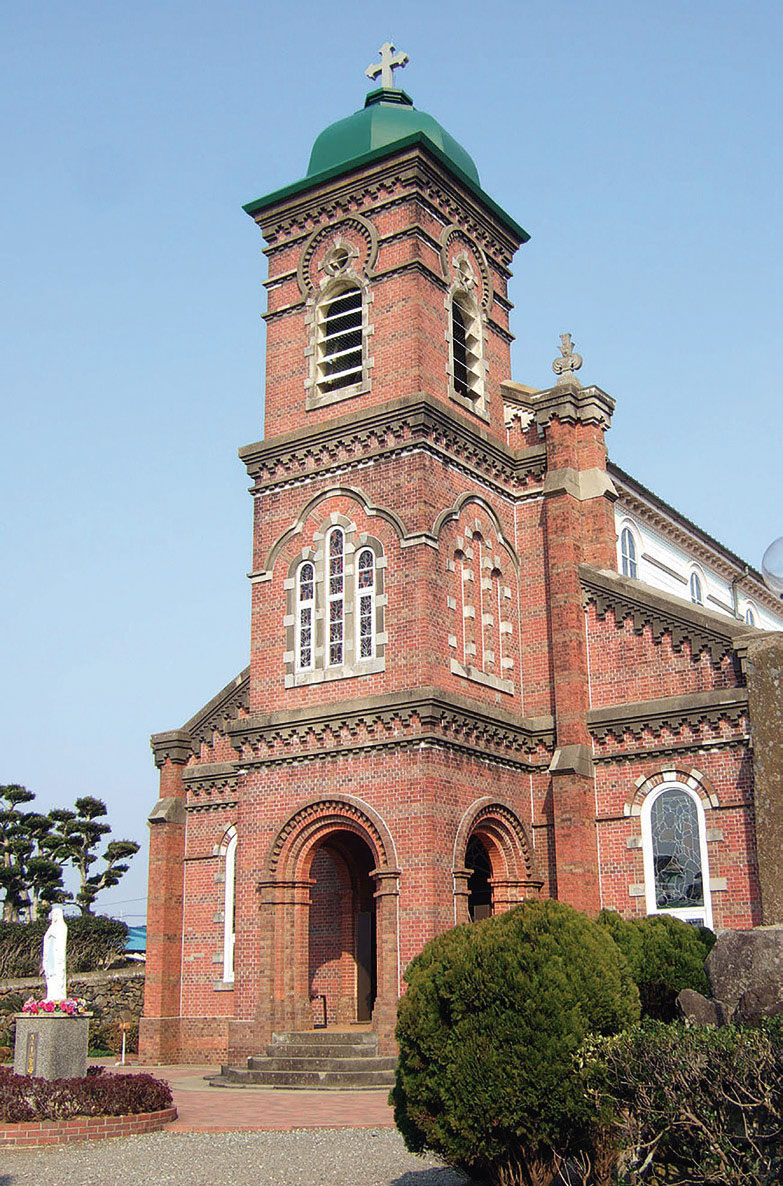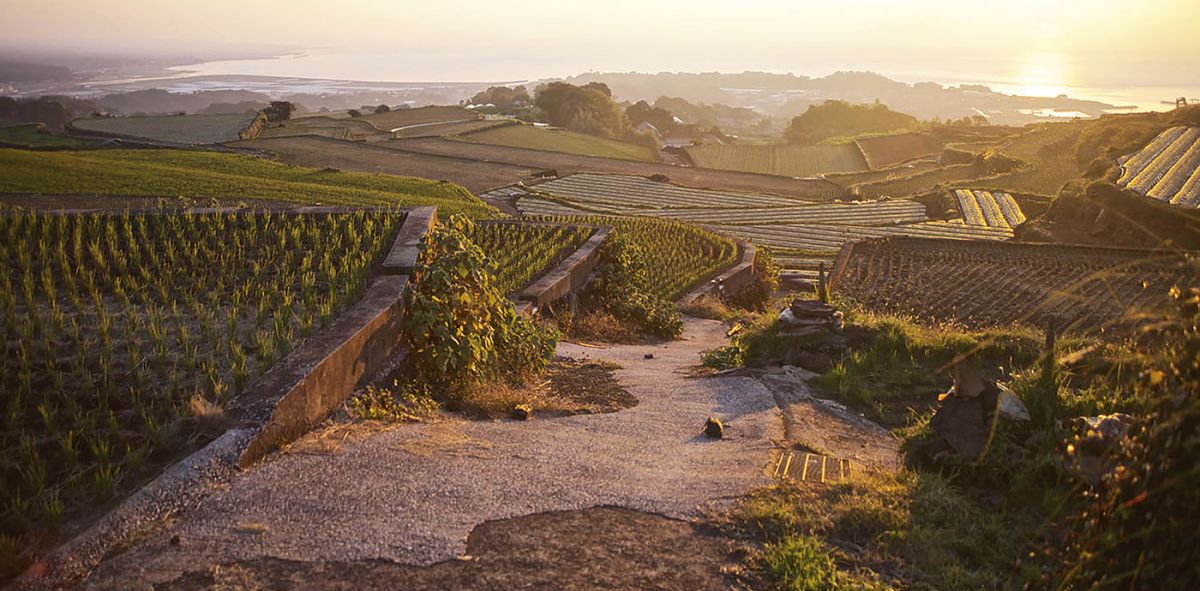A critical review of Catholic heritage sites in Nagasaki, Japan
<p>In July 2016, the Japanese government nominated a group of Catholic heritage sites in the Nagasaki region to the United Nations Educational, Scientific and Cultural Organization’s (UNESCO) World Heritage Committee for inclusion in the World Heritage List. This nomination comprises a collection of 12 sites that tell the story of the 250-year prohibition of the practice of Christian faith between the 17<sup>th</sup> and 19<sup>th</sup> centuries in Japan. The process of shaping what constitutes Catholic heritage in Nagasaki calls for an examination of the history, legacy and local knowledge that have been excluded from the official discourse that has accompanied this heritage. This essay explores how the discourse of Outstanding Universal Value (OUV) that has been used to support this nomination has shifted as different actors have become involved in the process of World Heritage-making. In particular, I examine the role of the advisory body to UNESCO, the International Council on Monuments and Sites (ICOMOS), in defining the significance of history of Japanese Catholicism used to justify the status of the proposed sites as World Heritage in light of the introduction of the history of ‘hidden Christians’ to an international audience.</p>
‘Underground Catholics’ in Nagasaki and the World Heritage Campaign
The Nagasaki region of Japan used to be the religious centre for Japanese Catholics and European missionaries during the 16th century, as the region served as Japan’s gateway for the exchange of knowledge, technology and culture with foreign countries. However, as the number of Japanese subjects and lords converting to Catholicism increased, feudal authorities perceived Christianity to be a threat to their ruling power and banned Christianity in the year 1612. During the period of Christian prohibition, all European missionaries were expelled from the country, while many Japanese Catholics went underground to escape persecution, hiding in remote areas in the Nagasaki region. These Catholics, who disguised themselves by publicly practicing Shinto/Buddhism while secretly maintaining their faith, are referred to as ‘underground Christians’ or ‘hidden Christians’. In this essay, I refer to them as ‘underground Catholics’ to be consistent with the historical background of this period, in which no missionaries from the other branches of Christianity, such as Protestantism, entered Japan. 1 Many of the underground Catholics were accused of heresy, while others refused to renounce their faith even in the face of exile, torture and death. 2
In the mid-19th century, Japan finally lifted its 250-year policy of closure to foreign countries and opened a few ports to the outside world, one of which was in Nagasaki. The first Catholic church was erected in Nagasaki after the ban on Christianity was lifted, but it was opened solely for foreigners residing within Nagasaki. In March 1865, however, a small group of underground Catholics secretly entered the church and asked a French priest, “Where is the statue of Santa Maria?” They then whispered: “All of us have the same heart as you.” This encounter led to the discovery of roughly 15,000 underground Catholics across the Nagasaki region.
Advocates for the preservation of Catholic heritage sites believe that a collection of Catholic historical sites can tell this rich and unique history of Japanese Catholicism in Nagasaki spanning a period of four centuries. The campaign for designating Nagasaki’s Catholic churches and heritage sites as World Heritage was initially launched by a citizen group called ‘To Declare a New World Heritage: The Nagasaki Church Group’ (hereafter ‘the Church Group’) in 2001. The group was composed of local Catholics, scholars and non-Christian citizens. This citizen group identified 49 Catholic churches throughout the Nagasaki Prefecture as potential candidates for World Heritage nomination. The members of the Church Group believed that these churches illustrated the “livingness” of the region’s Catholic heritage, being sites where local Catholic communities have maintained their religious values and ensured the continuity of their cultural tradition developed over a period of 450 years. They claimed that this living aspect of these churches constituted OUV. 3
Their campaign was successful. In January 2007, Nagasaki’s Catholic churches were registered in the UNESCO Tentative List for Japan, marking the intention to pursue a World Heritage List nomination; the sites were described as “testimonies of the suppressed adherents’ re-acquisition of religious freedom and its long process”. 4 In November 2007, the Prefectural Government of Nagasaki created a working group called the ‘Nagasaki World Heritage Scholarly Conference’ (NWHSC) as an official body to discuss the preservation campaign strategies for Catholic heritage sites and to write an application for nomination to the UNESCO World Heritage List. The NWHSC comprises members from both the public and private sectors, such as Nagasaki Catholic leaders, scholars, business leaders and civil servants. Gradually, the role of primary agent and stakeholder in the heritage campaign for these sites was shifted from the Church Group to the NWHSC. Between 2007 and 2012, the NWHSC repeatedly reviewed the components of the sites. Eventually, it listed 14 Catholic heritage sites and named the multi-site assemblage the ‘Christian Churches and Heritage Sites in Nagasaki’. 5 The proposed heritage complex consisted of the remains of two castles whose rulers converted to Catholicism during the 16th century; four villages where underground Catholics concealed themselves during the period of Christian prohibition; and eight Catholic churches that were built after the end of Christian prohibition. The NWHSC presented this heritage collection as sites of exchange and communication of traditional cultures between Japan and the West.
ICOMOS intervention in Nagasaki
In January 2015, Japan recommended the inscription of Catholic heritage sites to the UNESCO World Heritage List. In September of that year, a group of experts from ICOMOS came to Nagasaki to assess the application and the heritage property. In February 2016, ICOMOS recommended that the Japanese government dramatically review its application, asking that the application focus on the period of the ban on Christianity in Japan, which experts considered a period of exceptional significance in Nagasaki, rather than on the period that followed after the ban was lifted. In April 2016, the NWHSC invited ICOMOS to Nagasaki in order to refine its application. ICOMOS maintained its previous advice, telling the NWHSC to exclude sites that were not relevant to the Christian ban. ICOMOS also advised the NWHSC to include the term ‘hidden Christians’ in the title of the heritage property.
In the new version of the application to the World Heritage List, the property consists of 12 sites, 10 of which are villages where underground Catholics used to live, including one of the villages located in the Amakusa region in Kumamoto Prefecture. Nearly all the churches selected by the Church Group and the NWHSC — except the Ōura Cathedral, where underground Catholics revealed themselves to the French priest in 1865 —were eliminated from the final application. Instead, 7 Catholic churches were added to the list as they are located in these 10 villages that housed underground Catholics during the period of Christian prohibition.
The Tabira Cathedral is one of the churches that were excluded from the final list in the very last selection process from 2016 to 2017. After the end of banning Christianity, 8 families of former underground Catholics moved to a small village called ‘Tabira’ from different underground Catholics’ villages and built a humble temporary church. Tabira continued to receive former underground Catholics from other villages in Nagasaki. They reclaimed wasteland and finally built the Tabira Cathedral in 1918. The cathedral was dedicated to the 26 martyrs who were executed by crucifixion in Nagasaki in 1597. ICOMOS, however, claimed that the Tabira Cathedral is irrelevant to the period of Christian banning as Tabira became a Catholic village after the end of the ban, ignoring tremendous efforts and sacrifices the former underground Catholics made in order to transform the wasteland into the land of God.
The final application to the World Heritage List is titled the ‘Hidden Christian Heritage Sites in Nagasaki Prefecture and the Amakusa Region’. The application describes how underground Catholics “gave rise to a distinctive religious tradition that was seemingly vernacular yet maintained the essence of Christianity”, 6 adding that the property shows “the distinctive way in which the hidden Christians continued their faith during the ban on Christianity” and therefore has OUV. In July 2016, the Japanese government nominated the Catholic heritage sites to UNESCO’s World Heritage List. The final decision for a permanent registration is to be made in July 2018.
The intervention by ICOMOS experts played an important role in efforts to shed light on the history of underground Catholics. The period of Catholic persecution has never been a part of Japanese national history and very few people in Japan know that approximately 4,000 underground Catholics became martyrs, while thousands of other Catholics were sent into exile. After the official nomination to UNESCO, it became clear that no Japanese heritage stakeholders, including the local and national media, had ever considered the question of how people in Japan might come to terms with this forgotten or marginalized history. ICOMOS also contributed to honouring underground Catholics by representing this population to an international audience as courageous, faithful Japanese Catholics who developed a distinctive religious tradition.
However, some local scholars have also argued that ICOMOS experts, as well as members from the NWHSC, ignored certain aspects of local knowledge regarding the underground Catholics in the designation of boundaries for this nomination. First and foremost, the final application obscures the prominent differences between ‘underground Christians’ (Senpuku Kirishitan) and ‘hidden Christians’ (Kakure Kirishitan). ‘Hidden Christians’ is a more common and popular term both in Japan and abroad to describe Japanese Catholics during the period of Christian prohibition; however, ‘underground Christians’ refers to those who secretly maintained their faith during the period of Christian persecution. Hence, all Japanese Catholics during the period of Christian prohibition should be referred to as ‘underground Christians’. The term ‘hidden Christians’ refers specifically to those who decided not to belong to the Roman Catholic Church, but rather continued to maintain their own religious values and traditions developed over 250 years of persecution even after the Japanese government lifted the ban on Christianity. Notably, the Japanese title of the heritage property employs the term ‘underground Christians’, whereas the term ‘hidden Christians’ remains in the English title of the property.
When Catholicism was reintroduced in Japan after the end of Christian prohibition, many of the underground Catholics were stunned by the significant differences between official Catholic teachings and what they themselves had practiced for 250 years. Following the Roman Catholic Church also meant that they had to dismiss all the traditions that their ancestors had developed and handed down through generations. As a result, many of the former underground Catholics decided to live as ‘hidden Christians’ and continued to keep themselves isolated from mainstream society and the Catholic Church in Nagasaki in order to ensure the continuation of their own religious values and traditions. 7 They did not identify themselves as Catholics anymore and did not build a Catholic church. Equally important is the fact that hidden Christian communities still exist in the contemporary period. However, they are virtually disappearing as their communities are aging and depopulating, and no official conservation measures have been provided by the central government to preserve their traditions. 8
Disrupting continuity
In my research, I am concerned with revealing knowledge gaps between ICOMOS experts’ understanding of hidden Christians and local knowledge. There are two museums devoted to underground and hidden Christians in Hirado city, Nagasaki, 9 which used to be the land of underground Catholics and continues to house hidden Christian communities. The archival and material collections in these museums as well as the curators’ historical and ethnographic knowledge are essential to understanding the history of Japanese Catholicism in the region. However, none of the ICOMOS experts visited these museums during their stay in Hirado city or tried to learn the history of hidden Christians from the local curators in these museums. Likewise, the NWHSC did not include any of these curators or ethnographers on their selection committee. As a result, the NWHSC was incapable of communicating to the foreign experts from ICOMOS that ‘hidden Christians’ are living communities in the present, and that isolating the history of underground Catholics from the period after Christian prohibition would not only contribute to the further marginalization of hidden Christians and the erasure of their rich history and particular cultural traditions, but also disrupt the continuity between the period of Christian persecution and the present time.
Shigeo Nakazono, an ethnographer and a curator of the hidden Christian museum in Hirado, claims that, as time passed, underground Catholics genuinely sought ways of co-existing with Buddhism/Shintoism in order to keep their faith; not all the underground Catholics ‘disguised’ themselves as Shinto/Buddhists. 10 Nakazono argues that the significance of the underground/hidden Christians in Japanese society is their practice of embracing others’ religions in order to maintain their own—precisely because they witnessed how ignorance and rejection of others’ faiths and values caused brutal violence. Prior to the period of Christian persecution, European missionaries had ordered Japanese Catholics to persecute non-Catholics, including Buddhist monks and Shinto priests, and to burn down temples and shrines in order to propagate Catholicism during the 16th century. 11 Yet this significant part of history is now completely excluded from the official discourse of Catholic heritage in Nagasaki on account of the type of sites and narratives that were selected to represent and justify this nomination. The official representation of underground Catholics as it stands authenticates their history and practices for an international audience; however, a romanticized image of underground Catholics that excludes the periods before and after their persecution can undermine the truly significant elements of their history, which invokes tremendous sacrifice and tolerance.
Conclusion
This case study raises the issue of how local voices and ethnographic knowledge of Japanese Catholicism Christianity are used – or in this case, excluded – from the process of defining the Outstanding Universal Value of a property. The final application has betrayed the wishes of local Catholics for the conservation of their churches as living heritage as the role of primary agent in the heritage campaign shifted from the Church Group to the NWHSC and ICOMOS. The nomination process of Nagasaki’s Catholic heritage sites has raised some crucial questions: How should heritage experts, including ICOMOS, deal with religious heritage that implicates extremely delicate narratives and histories? How can local heritage-makers effectively communicate with ICOMOS experts? How can critical heritage scholars advocate for the importance of including local ethnographers and curators in the process of heritage-making? Japan’s nomination of Catholic heritage sites to the UNESCO World Heritage List is only the beginning of the exploration of the legacy of Japanese underground Catholics and what their sacrifice can signify to humanity.
Tomoe Otsuki, Research Associate of the York Centre for Asian Research, York University, Toronto, Canada (tomoe.otsuki1219@gmail.com).


